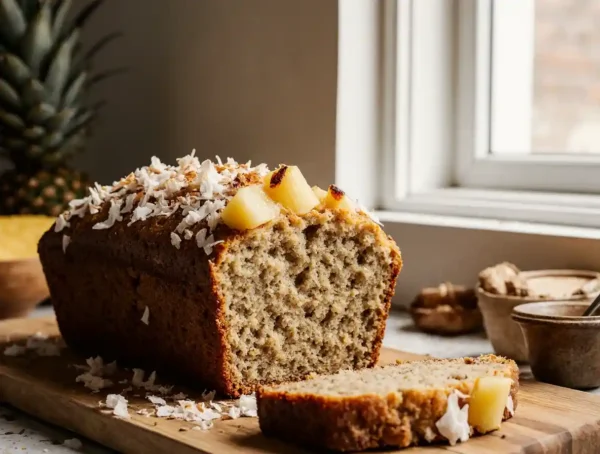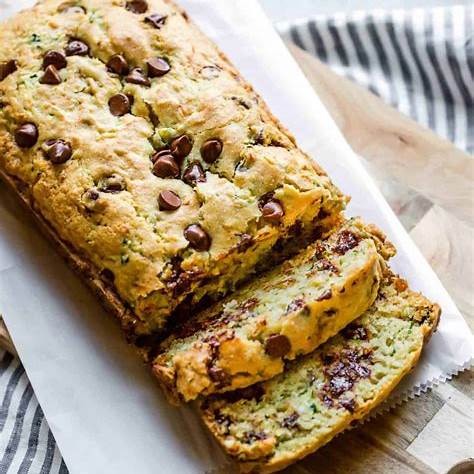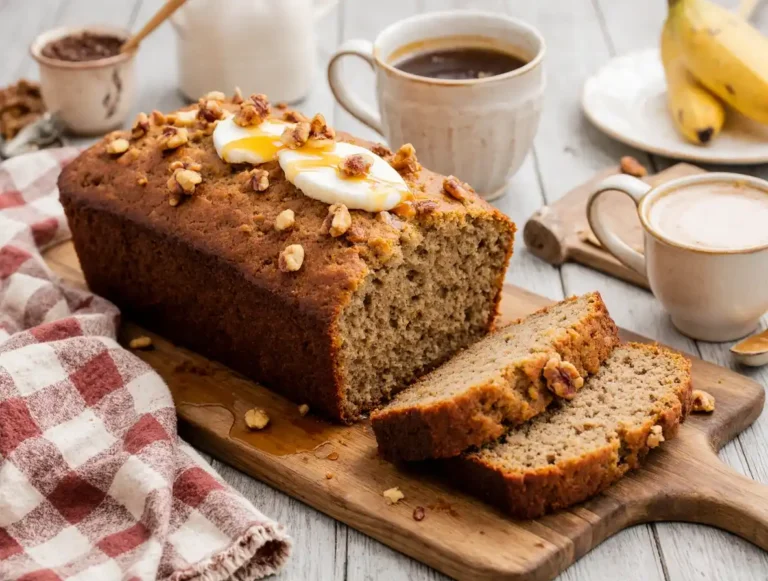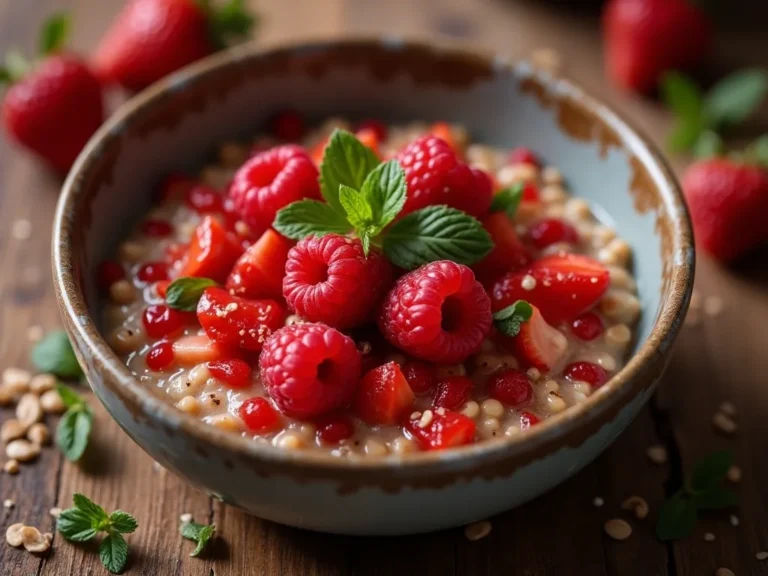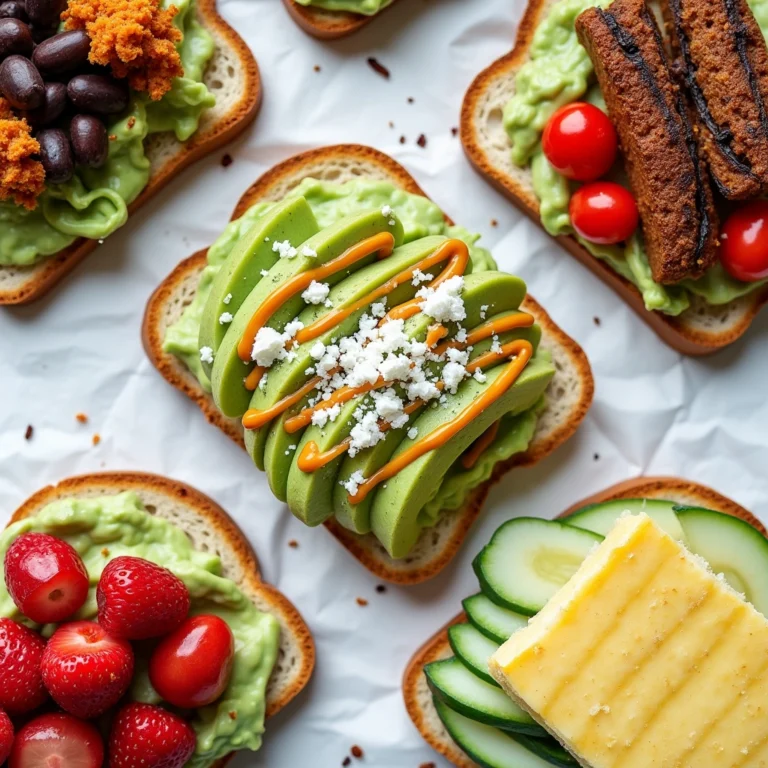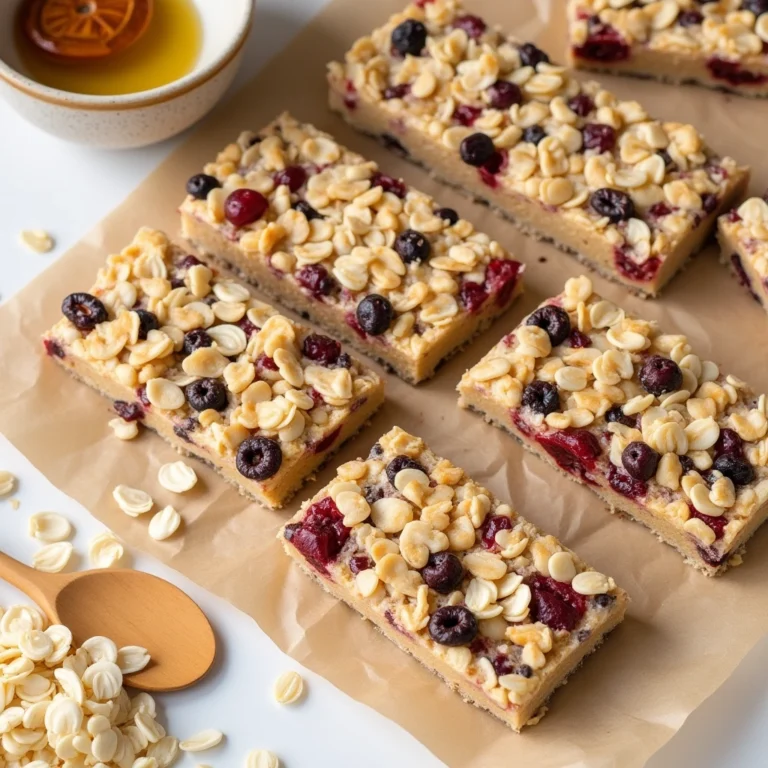Irresistible Hawaiian Banana Bread Recipe number 1
Enjoy the tropical taste of Hawaiian banana bread with coconut, macadamia nuts, and pineapple. A delicious island-inspired treat!
Introduction: What Makes Hawaiian Banana Bread Special?
Hawaiian banana bread stands out for its unique blend of tropical flavors, fresh ingredients, and cultural influences. While banana bread is a popular treat across many regions, the version from Hawaii carries distinct qualities that make it special. These elements combine to create a moist, flavorful loaf that reflects the islands’ diverse environment and traditions.
Moist pineapple banana bread from Taste of Home Pineapple Banana Bread
1. Use of Tropical Ingredients
One of the most significant factors that set Hawaiian banana bread apart is the incorporation of tropical ingredients. While the main ingredient, ripe bananas, remains consistent with traditional recipes, Hawaiian banana bread often includes flavors like coconut, macadamia nuts, and pineapple. These additions add a layer of complexity, turning a simple banana bread into a rich, island-inspired treat.
- Coconut: Often included in the form of shredded coconut, this ingredient adds both texture and a hint of sweetness. Coconut is a staple in Hawaiian cuisine and provides the bread with a subtle tropical aroma.
- Macadamia Nuts: Known as Hawaii’s signature nut, macadamias lend a buttery crunch that pairs beautifully with the softness of the banana bread. Their rich, creamy flavor is a hallmark of the islands and is often sprinkled throughout the batter.
- Pineapple: Some recipes incorporate pineapple, either fresh or as juice, for an extra burst of tangy sweetness. The fruit’s moisture also helps make the bread even more tender, adding to its soft, cake-like texture.
2. Rich, Moist Texture
Hawaiian banana bread is particularly known for its moist and dense texture. The use of ripe bananas, which are often overripe, ensures that the bread remains soft and flavorful. Overripe bananas contain more sugar and moisture, which results in a sweeter, more flavorful loaf. Additionally, the butter and sometimes even sour cream or yogurt contribute to a rich, tender crumb.
The dense texture also allows the bread to hold up well when served as a snack or dessert, making it an ideal treat for both casual gatherings and more formal occasions.
3. Cultural Influence
The cultural influence of Hawaii can be seen in the ingredients and preparation methods of the banana bread. Hawaiian cuisine is a blend of native Hawaiian, Asian, and Western influences, creating a unique fusion of flavors. This fusion is evident in the use of local ingredients like macadamia nuts and coconut, which are staples in many Hawaiian dishes.
Moreover, the tradition of baking and sharing food plays a significant role in Hawaiian hospitality. Banana bread, often made in large batches, is shared with friends and family, symbolizing the warm, welcoming spirit of the islands. It’s not just a snack—it’s a gesture of “Aloha,” the Hawaiian word for love, peace, and compassion.
Ingredients
Before you start, gather the following ingredients:
- 3 ripe bananas (the riper, the better for sweetness and moisture)
- 1/2 cup butter, melted (unsalted is recommended)
- 1 cup brown sugar (you can substitute with white sugar or a mix of both)
- 2 large eggs
- 2 cups all-purpose flour
- 1 tsp baking soda
- 1/4 tsp salt
- 1 tsp vanilla extract
- 1/2 cup shredded coconut (optional, but adds a wonderful tropical flavor)
- 1/2 cup chopped macadamia nuts (optional but highly recommended for a crunchy texture)
- 1/2 cup crushed pineapple (optional, but gives the bread extra moisture and a fruity kick)
- 1/2 tsp ground cinnamon (optional, for added warmth)
- 1/2 cup sour cream or yogurt (optional, for extra moisture and richness)
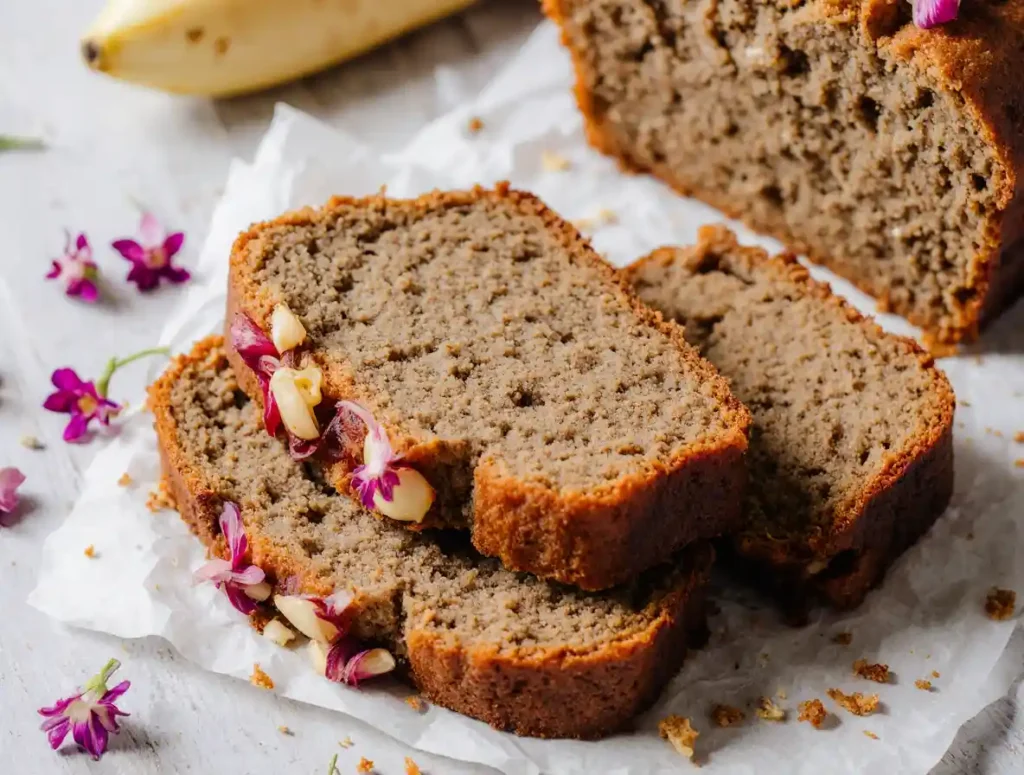
Step-by-Step Instructions
Step 1: Preheat the Oven
Preheat your oven to 350°F (175°C). This ensures the oven is at the right temperature for baking the banana bread. While the oven is heating up, prepare the loaf pan.
Step 2: Prepare the Loaf Pan
Grease a 9×5-inch loaf pan with butter or non-stick cooking spray. You can also line it with parchment paper to prevent the bread from sticking and make it easier to remove after baking.
Step 3: Mash the Bananas
Peel the ripe bananas and place them in a large mixing bowl. Use a fork or potato masher to mash the bananas until smooth. It’s okay to leave a few small chunks for extra texture.
Step 4: Mix Wet Ingredients
To the mashed bananas, add the melted butter, brown sugar, and vanilla extract. Stir the mixture well until everything is fully combined. Add the eggs one at a time, mixing after each addition.
Step 5: Mix Dry Ingredients
In a separate bowl, whisk together the flour, baking soda, salt, and cinnamon (if using). This helps to evenly distribute the dry ingredients, ensuring a uniform rise in the bread.
Step 6: Combine Wet and Dry Ingredients
Gradually add the dry ingredients to the wet banana mixture, stirring gently until just combined. Be careful not to overmix, as this can result in a dense loaf.
Step 7: Add Tropical Add-ins
Fold in the shredded coconut, chopped macadamia nuts, and crushed pineapple (if using). These ingredients are what make this banana bread unique, giving it a tropical flair and an extra burst of flavor.
Step 8: Pour the Batter into the Pan
Once everything is well combined, pour the banana bread batter into the prepared loaf pan. Use a spatula to smooth the top of the batter so it cooks evenly.
Step 9: Bake the Bread
Place the loaf pan in the preheated oven and bake for 60 to 75 minutes. The banana bread is done when a toothpick or cake tester inserted into the center comes out clean or with a few moist crumbs. If the top starts to brown too quickly, cover it loosely with aluminum foil and continue baking.
Step 10: Let It Cool
Once the bread is done, remove it from the oven and let it cool in the pan for about 10 minutes. After that, transfer the bread to a wire rack to cool completely. Allowing the bread to cool helps it set properly and enhances the flavor.
Step 11: Slice and Serve
Once the bread has cooled, slice it into thick, generous pieces. Serve it on its own, or with a dollop of whipped cream or a spread of butter for extra indulgence. You can also serve it with tropical fruits or a glass of iced tea to enjoy a full Hawaiian-inspired experience.
Tips for the Perfect Hawaiian Banana Bread
- Use Overripe Bananas: The riper your bananas, the sweeter and more flavorful the bread will be. Overripe bananas have more sugar and moisture, contributing to the perfect texture.
- Don’t Overmix: When combining the wet and dry ingredients, stir gently. Overmixing can lead to tough, dense bread. It’s okay if there are a few lumps in the batter.
- Customize with Add-ins: Feel free to adjust the add-ins to your liking. You can use walnuts instead of macadamia nuts, or omit the pineapple if you prefer a more classic banana bread flavor.
- Try a Quick-Freezing Method: If you have leftover banana bread, you can freeze slices by wrapping them tightly in plastic wrap or aluminum foil and storing them in a freezer-safe bag. This way, you can enjoy banana bread anytime!
Want a variation? try this Hawaiian Banana Nut Bread
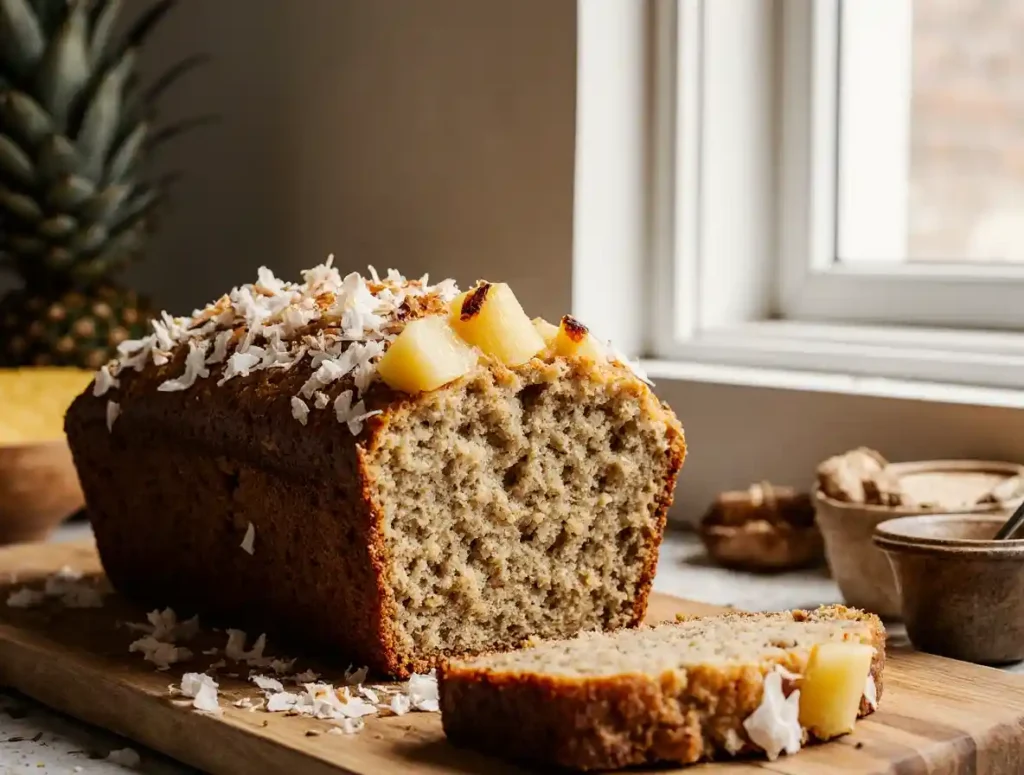
Healthier Alternatives to Traditional Hawaiian Banana Bread
Hawaiian banana bread is undeniably delicious, but for those looking to make a healthier version without sacrificing flavor, there are several alternatives that can be easily incorporated into the recipe. These swaps maintain the moist, rich texture and tropical flavors of traditional banana bread while offering lower sugar, healthier fats, and additional nutritional benefits. Here are some simple and effective ways to make a lighter, healthier Hawaiian banana bread:
1. Use Whole Wheat or Almond Flour
Instead of using all-purpose flour, try replacing it with whole wheat flour or almond flour. Whole wheat flour provides more fiber, which aids digestion and helps you feel fuller for longer. Almond flour, on the other hand, is gluten-free and packed with protein, healthy fats, and vitamin E. Both of these options offer a heartier texture and additional nutritional benefits compared to refined flour.
- Whole Wheat Flour: Use a 1:1 substitution for all-purpose flour, but you may need to add a little more liquid to compensate for the denser texture.
- Almond Flour: You might need to adjust the ratios slightly since almond flour is more dense than all-purpose flour. A common substitution is about 1 cup of almond flour for every 1.25 cups of all-purpose flour.
2. Lower the Sugar Content
Traditional Hawaiian banana bread often calls for a cup of brown sugar, but this can easily be reduced or replaced with healthier alternatives. Here are a few options to consider:
- Reduce the Sugar: You can cut the sugar in half or even eliminate it completely if your bananas are very ripe. Overripe bananas naturally provide plenty of sweetness, making the bread flavorful without added sugar.
- Natural Sweeteners: Instead of refined sugar, try using honey, maple syrup, or coconut sugar. These natural sweeteners provide additional nutrients and have a lower glycemic index, which helps avoid the blood sugar spikes associated with refined sugars.
3. Use Coconut Oil Instead of Butter
Traditional Hawaiian banana bread recipes typically call for butter, but using coconut oil can make the bread healthier by reducing saturated fat while still maintaining a rich, moist texture. Coconut oil also adds a subtle tropical flavor that pairs perfectly with the other ingredients like coconut flakes and macadamia nuts.
- Coconut Oil: Use the same amount of coconut oil as butter. Opt for virgin coconut oil to get the most health benefits, including medium-chain triglycerides (MCTs), which are known for their metabolism-boosting properties.
4. Add Ground Flaxseeds or Chia Seeds
To boost the nutritional value of your Hawaiian banana bread, consider adding ground flaxseeds or chia seeds. These tiny seeds are packed with omega-3 fatty acids, fiber, and antioxidants, which help support heart health, improve digestion, and provide long-lasting energy. They also add a slightly nutty flavor and texture to the bread.
- Flaxseeds: Use about 2 tablespoons of ground flaxseeds to replace one egg in the recipe. You can also add them directly to the batter for extra fiber.
- Chia Seeds: These can be added whole or soaked in water for a few minutes before adding them to the bread. They absorb moisture and help keep the bread moist, while also contributing healthy fats and fiber.
5. Substitute Eggs with Flaxseed or Chia Egg
If you’re looking to make a vegan or lower-cholesterol version of Hawaiian banana bread, you can replace the eggs with flaxseed eggs or chia eggs. These egg substitutes are made by mixing ground flaxseeds or chia seeds with water, which forms a gel-like consistency that binds the ingredients together just like eggs.
- Flaxseed Egg: To make one flaxseed egg, combine 1 tablespoon of ground flaxseeds with 3 tablespoons of water. Let it sit for a few minutes to thicken before adding it to the batter.
- Chia Egg: Similarly, combine 1 tablespoon of chia seeds with 3 tablespoons of water and let it sit to form a gel. Use this mixture as a replacement for one egg.
6. Add Greek Yogurt for Extra Protein
Instead of sour cream, consider adding Greek yogurt to your Hawaiian banana bread. Greek yogurt is an excellent source of protein and probiotics, which are beneficial for gut health. It also adds a creamy texture and slight tang that balances the sweetness of the bananas.
- Greek Yogurt: Replace sour cream with Greek yogurt in a 1:1 ratio. This swap not only makes the bread healthier but also enhances the flavor and moisture of the loaf.
7. Opt for Dark Chocolate Chips
If you like to add chocolate to your Hawaiian banana bread, choose dark chocolate chips instead of milk chocolate chips. Dark chocolate is packed with antioxidants and has less sugar than milk chocolate, making it a healthier choice. It also complements the sweetness of the bananas and adds a rich, slightly bitter flavor that contrasts beautifully with the tropical ingredients.
- Dark Chocolate: Choose dark chocolate with at least 70% cocoa to reap the full health benefits of antioxidants and lower sugar content.
8. Incorporate More Fruits and Nuts
To make your Hawaiian banana bread even more nutritious, you can increase the amount of fruits and nuts included in the recipe:
- Pineapple: Fresh or unsweetened canned pineapple can add extra fiber and vitamin C to your bread. Just make sure to drain the juice if using canned pineapple.
- Nuts: Add walnuts, pecans, or almonds for a healthy dose of protein and omega-3 fatty acids. These nuts also add texture and crunch, making the banana bread more satisfying.
9. Cut Back on Portion Size
Even with healthier ingredients, portion control is key. Instead of serving large slices, cut the bread into smaller portions to help control calorie intake. Consider serving your banana bread with a side of fresh fruit or a light yogurt dip to balance the sweetness.
try this version of banana bread from Hawaii or compare it with Grandma’s banana nut version for a nostalgic twist.
Frequently Asked Questions About Hawaiian Banana Bread
Hawaiian banana bread is a beloved treat known for its rich flavors, moist texture, and tropical ingredients. If you’re considering making it at home or simply want to learn more, here are some frequently asked questions about this delicious island-inspired loaf.
1. Why is Hawaiian Banana Bread so Popular?
Hawaiian banana bread is popular because it combines the classic comfort of banana bread with tropical ingredients like coconut, macadamia nuts, and pineapple. The bread is rich, moist, and flavorful, making it a favorite among locals and visitors alike. Additionally, it’s often made as a gift or souvenir, adding to its widespread appeal.
2. Can I Make Hawaiian Banana Bread Without Nuts or Coconut?
Yes, you can make Hawaiian banana bread without nuts or coconut. These ingredients are optional and add texture and tropical flavor to the bread, but if you prefer a simpler version, feel free to omit them. The banana bread will still be delicious, although it will lack the signature tropical crunch.
3. How Can I Make Hawaiian Banana Bread Vegan?
To make Hawaiian banana bread vegan, you can replace the eggs with a flaxseed or chia egg, as well as use dairy-free butter and yogurt. Coconut oil can be used instead of butter, and you can choose a non-dairy milk if you prefer. Make sure to use plant-based ingredients like non-dairy yogurt and coconut milk to maintain the bread’s moisture and richness.
4. What is the Best Way to Store Hawaiian Banana Bread?
To store Hawaiian banana bread, wrap it tightly in plastic wrap or aluminum foil and keep it at room temperature for up to 3-4 days. If you want to keep it longer, store the wrapped bread in the refrigerator for up to a week. Alternatively, you can freeze the banana bread for up to 3 months by wrapping it tightly and placing it in a freezer-safe bag.
5. Can I Freeze Hawaiian Banana Bread?
Yes, you can freeze Hawaiian banana bread. To freeze, wrap it tightly in plastic wrap or aluminum foil, and then place it in an airtight container or freezer-safe bag. When you’re ready to enjoy it, let it thaw at room temperature for several hours or warm it in the oven at a low temperature to restore its moisture.
6. Why Does My Banana Bread Turn Out Dry?
If your banana bread turns out dry, it could be due to overbaking, using not-ripe enough bananas, or overmixing the batter. To prevent dryness, make sure the bananas are very ripe (overripe is best) and check the bread for doneness by inserting a toothpick. It should come out clean, but the bread should not bake for longer than necessary. Additionally, make sure to measure your flour properly and avoid overmixing the batter to keep the loaf moist.
7. Can I Make Hawaiian Banana Bread Gluten-Free?
Yes, Hawaiian banana bread can be made gluten-free by substituting the all-purpose flour with a gluten-free flour blend. Make sure to choose a blend that is designed to substitute for regular flour in baked goods. You may also want to add a teaspoon of xanthan gum to help provide structure and texture to the bread.
8. What Other Add-ins Can I Include in Hawaiian Banana Bread?
Beyond coconut, macadamia nuts, and pineapple, you can experiment with other tropical ingredients like dried mango, papaya, or shredded papaya. You can also include different types of nuts like walnuts or almonds, or even chocolate chips for a richer, sweeter flavor.
9. Can I Use Overripe Bananas for Hawaiian Banana Bread?
Yes, overripe bananas are actually the best choice for making banana bread. The extra sugar and moisture in overripe bananas contribute to a sweeter, moister loaf. Be sure to use bananas that are heavily speckled or even fully brown for the best results.
10. What Can I Serve with Hawaiian Banana Bread?
Hawaiian banana bread can be enjoyed on its own, but it pairs wonderfully with a variety of toppings or sides. Consider serving it with a spread of butter, a drizzle of honey, or a dollop of whipped cream. For a more tropical experience, serve it with fresh fruit like pineapple or mango slices, or even a scoop of vanilla ice cream.
Conclusion
Hawaiian banana bread is a delightful and versatile treat that brings together the comforting flavors of banana bread with the tropical influences of Hawaii. Whether you’re making it with traditional ingredients or exploring healthier alternatives, this bread offers a delicious way to enjoy the tastes of the islands. With its rich, moist texture and tropical flavors, Hawaiian banana bread is perfect for any occasion, from casual snacks to special gifts. By following the simple tips and variations shared, you can easily create a loaf that captures the essence of Hawaii right in your own kitchen.

